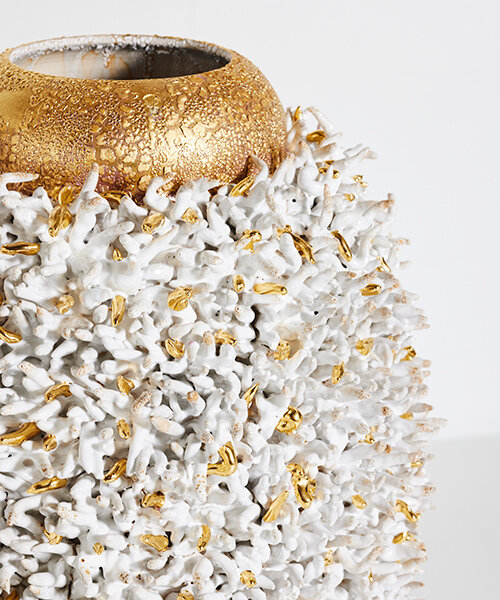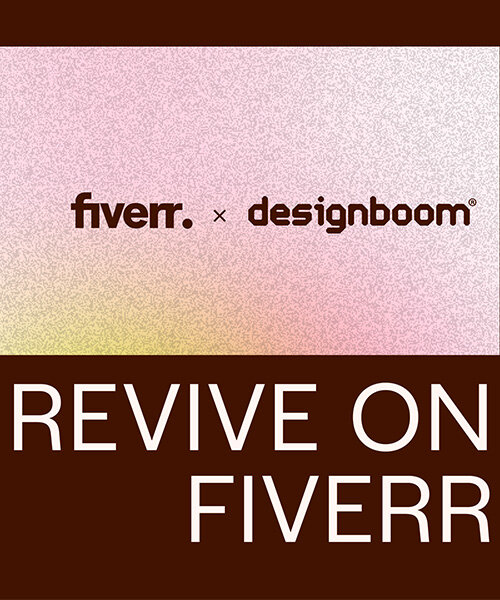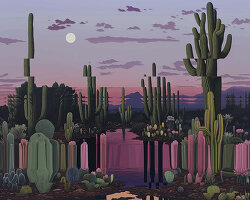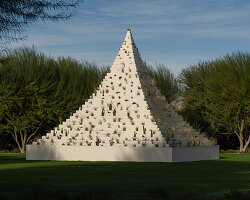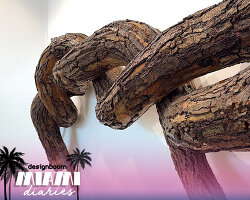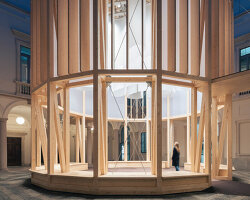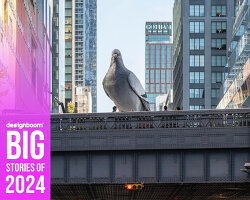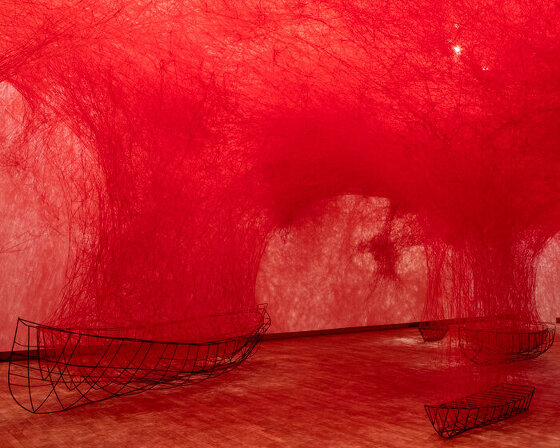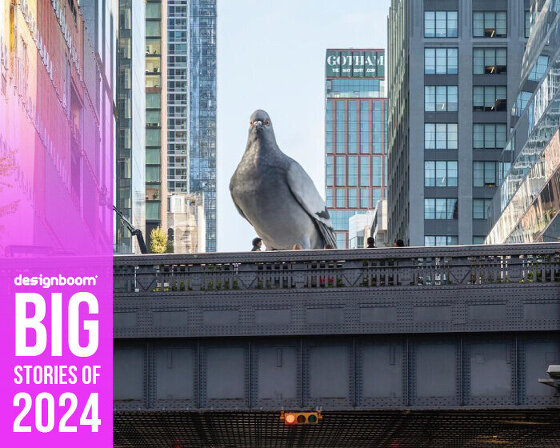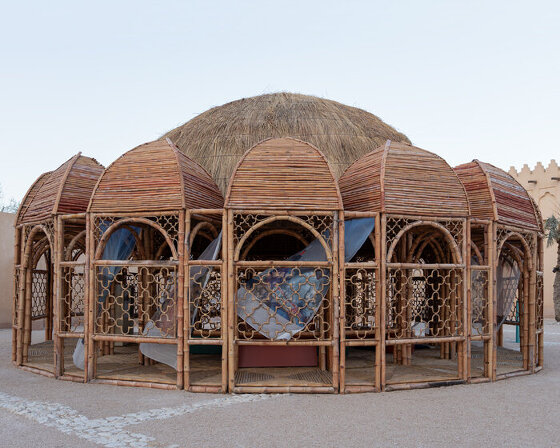three concurrent solo shows open at southern guild cape town
On view through August 22nd, Southern Guild Cape Town has unveiled three compelling solo exhibitions: each show displays the diverse talents of artists Adam Birch, King Houndekpinkou, and Madoda Fani, presenting unique bodies of work. The gallery highlights the individual artistic journeys of each artist inviting viewers to engage with larger themes of materiality, cultural fusion, and identity. designboom interviewed Birch, Houndekpinkou, and Fani to explore their creative processes and inspirations — through their distinct practices, the three artists contribute to a rich dialogue on the interconnectedness of human experience and the natural world.
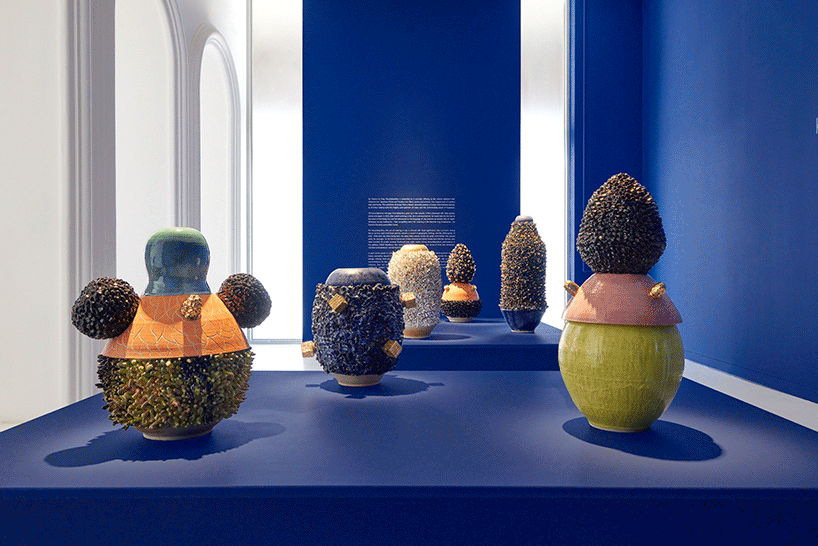
exhibition views | images © Hayden Phipps, Southern Guild
Adam Birch: like something almost being said
Adam Birch’s show, Like Something Almost Being Said, features a collection of functional timber sculptures, entirely hand-sculpted from locally felled trees. The artist‘s practice is rooted in a deep understanding of the materiality of wood, developed over two decades as an arborist. His works are characterized by their soft curves and prongs, emerging organically from the tree’s natural form without the use of traditional joinery. Birch’s pieces invite viewers into an intimate conversation between object and maker, embodying the natural lifecycle and inherent beauty of the timber. Through the arduous and physical process of sculpting with a chainsaw, Birch creates fluid, organic forms that transcend their material origins.
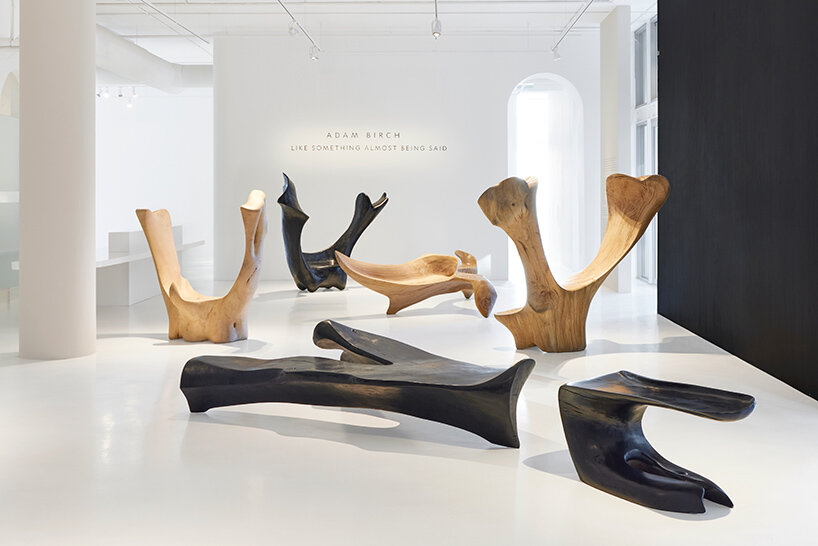
Adam Birch, Like Something Almost Being Said, exhibition view | image © Hayden Phipps, Southern Guild
designboom (DB): Your exhibition, Like Something Almost Being Said, comprises sculptures crafted from locally felled trees. Can you elaborate on how your background as an arborist has influenced your approach to working with wood and the creation of these unique forms?
Adam Birch (AB): My work as an arborist and my work as an artist are very much tied to one another. When it comes to dismantling the tree, you have to be aware of its structural nature and how best to fell it in a way that ensures the integrity of the tree’s shape is intact. So much of my knowledge around the material has been built through my work as an arborist. That work has allowed me to cultivate an understanding of the wood’s grain, its density, its porosity, the form’s balance – it informs everything I make.
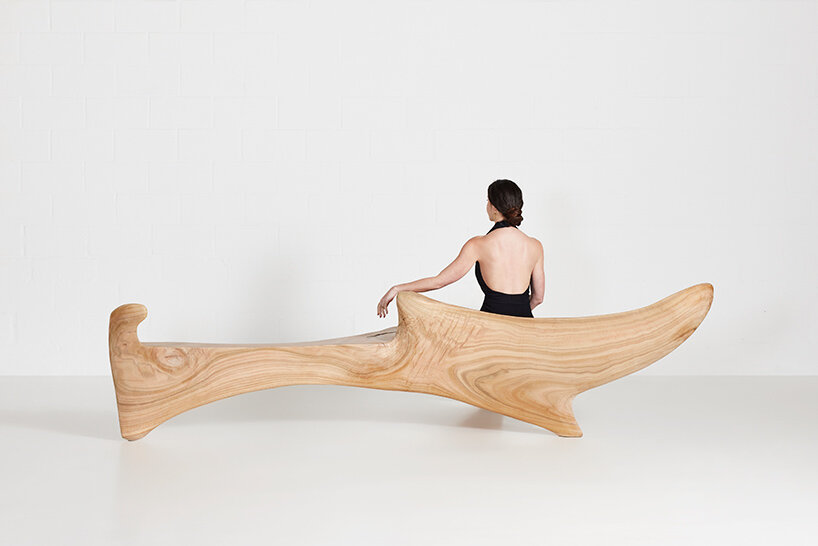
Adam Birch, Swan, 2024 | image © Hayden Phipps, Southern Guild
DB: Your process involves using a chainsaw to sculpt the timber, a method you describe as both brutal and intense. What draws you to this unconventional tool, and how does it shape your artistic expression and relationship with the material?
AB: I’ve been using chainsaws for so long I am able to make them do things they weren’t designed to do. The tool has been built to cut clean, straight angles and lines – I know how to shape curvilinear forms that appear fluid, refined, organic. Using this tool in such an unconventional way heightens the element of danger. With the sheer noise, sawdust and proximity of risk, I suppose I’ve grown attached to this kind of endorphin-fuelled making. Seeing how far I can push the material is pretty thrilling. It propels me to be bold, to see just how far I can push the material and ultimately, to extract more ambitious shapes and formal expressions from the timber.
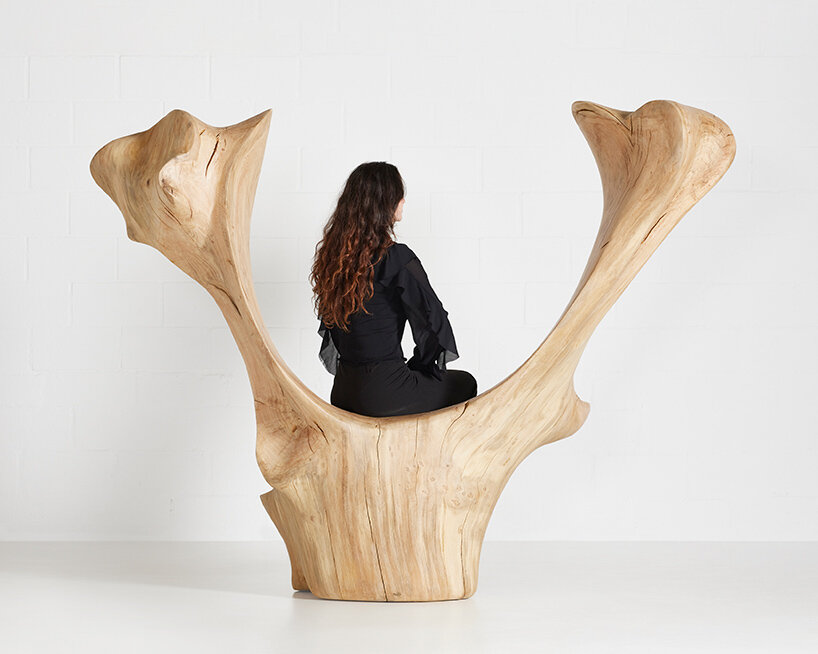
Adam Birch, Sacrum, 2024 | image © Hayden Phipps, Southern Guild
DB: The exhibition title is inspired by Philip Larkin’s poem ‘The Trees,’ which deals with themes of mortality and renewal. How do these themes resonate with your work, and how do you see your sculptures embodying these ideas?
AB: All of my sculptural works have been made from pieces of timber that would have otherwise been discarded. There’s something magnificent in taking any material deemed obsolete and re-crafting it into an object of renewed purpose and function, something cherished and desirable. Larkin’s poem speaks to the innate cyclicality of life, death, loss, and the transience of corporeal beauty. Trees – and the material they offer – embody this ephemeral quality. They are birthed, they grow, they die and return to the earth. My works offer another stage in their life cycle – one of transformative reinvigoration, I hope.
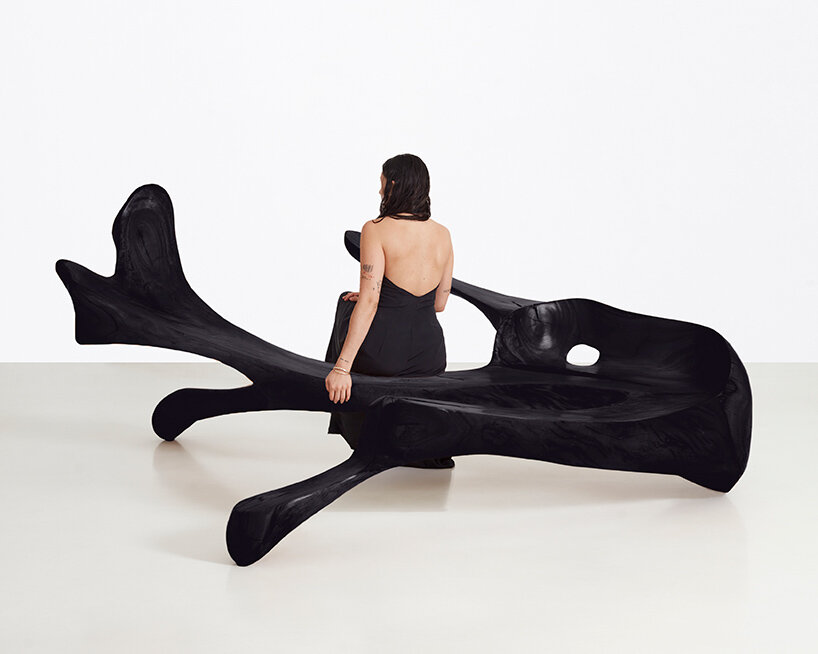
Adam Birch, Legato Recliner (stained), 2022 | image © Hayden Phipps, Southern Guild
DB: You mention that you let the timber guide you in the creation process, pushing the boundaries of what the material can hold. Can you share a specific instance where the wood led you to an unexpected outcome or revelation in your work?
AB: Every form’s process is unexpected. It’s like a box of chocolates. Only once I start cutting into the form do I get a true understanding of the life of the inner wood and how best to work with it. There might be pockets that are rotten that need to be carved away, cracks that demand the eventual form take a particular shape, the outer sap wood might have a different density to the wood at the inner heart. The heart wood holds the toxins, storing all the by-products from photosynthesis. It’s dense and unpredictable. This process of discovery means that each work is a unique revelation.
DB: Your practice is connected to the outdoors and the elements, a contrast to the typical studio environment. How does this connection to nature and the external environment impact your creative process and the final pieces you produce?
AB: My studio is outdoors in an area close to the peninsula’s coast. Each day’s work is largely dependent on what the weather is doing. I’ve had to learn to work with — and often in spite of — wind, sun, rain and humidity. But I’ve come to love this rugged process, it requires patience and presence. It’s changeable, like the material itself.
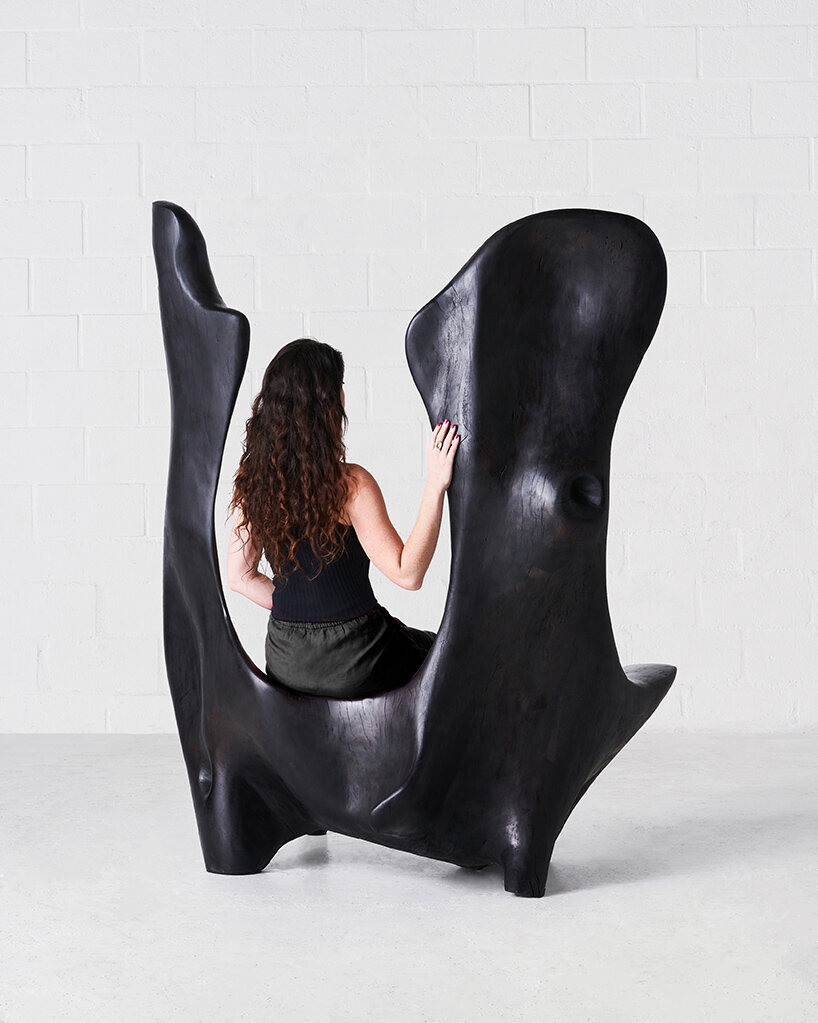
Adam Birch, Boudicca, 2023 | image © Christofvander Walt, Southern Guild
King HOUNDEkPINKOU
King Houndekpinkou’s Six Prayers presents a series of six large-scale ceramic sculptures that blend tradition with modernity. Drawing from both Japanese and West African cultures, Houndekpinkou’s work embodies a syncretic approach, fusing ancient spirituality with contemporary techniques. His guiding philosophy of interdependence and the divine nature of life is reflected in the alchemical processes and textures of his ceramics. The pieces in this exhibition are a vibrant exploration of form and color, pairing smooth surfaces with rough textures, and matte finishes with glossy glazes. The artist‘s vessels, created during his GUILD residency in Cape Town, serve as ritualistic objects in a new mythological narrative and offer a sensory experience.
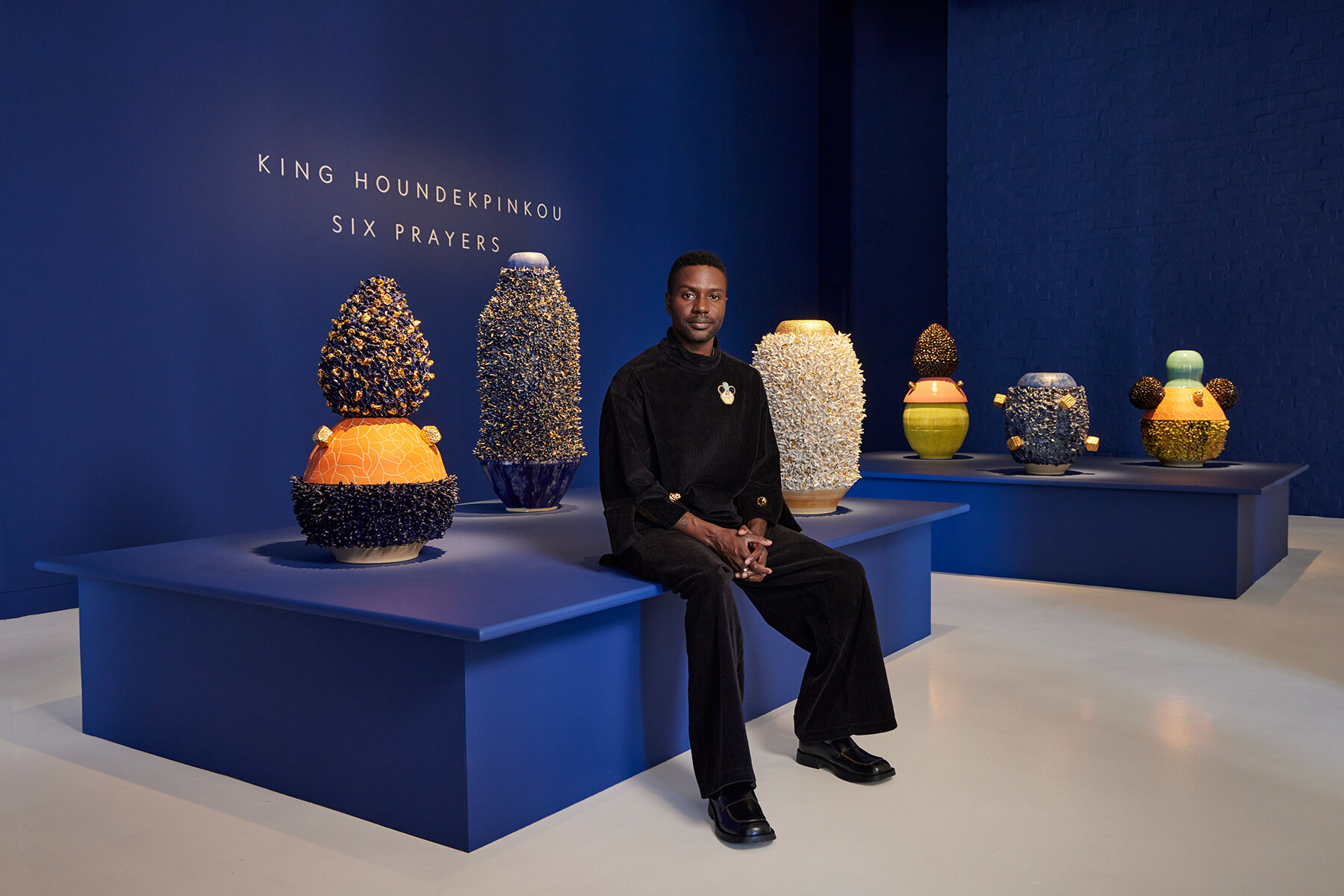
King Houndekpinkou, Six Prayers, portrait and exhibition view | image © Hayden Phipps, Southern Guild
designboom (DB): Six Prayers features a distinctive blend of Japanese and West African cultural elements. Can you describe the journey that led you to integrate these diverse influences in your work?
King Houndekpinkou (KH): When I started training and working as an assistant with my ceramist friends in Bizen, Japan, I sensed their ceremonial approach to creating ceramics which, I believe, was rooted in their Shintoism and Buddhist beliefs. They personified and respected the clay in a religious way. They prayed and made offerings to the ‘Kiln God’ before each firing. To me, such gestures were reminiscent of the Vodun ceremonies of Benin, the country of my roots.
Their discipline and dedication towards clay work were alluring to me as a whole art in and of itself. A way of living and being. That’s how I wanted to practice ceramics. Following that epiphanic experience, I perceived clay as the matter that bonded both cultures. But not only that — it’s also a symbolic material that is inherent to a large number of religions and belief systems. I then searched for ways to express that idea of cultural and spiritual syncretism using my very own imagination and the skills I learned practicing ceramics in both France and Japan.
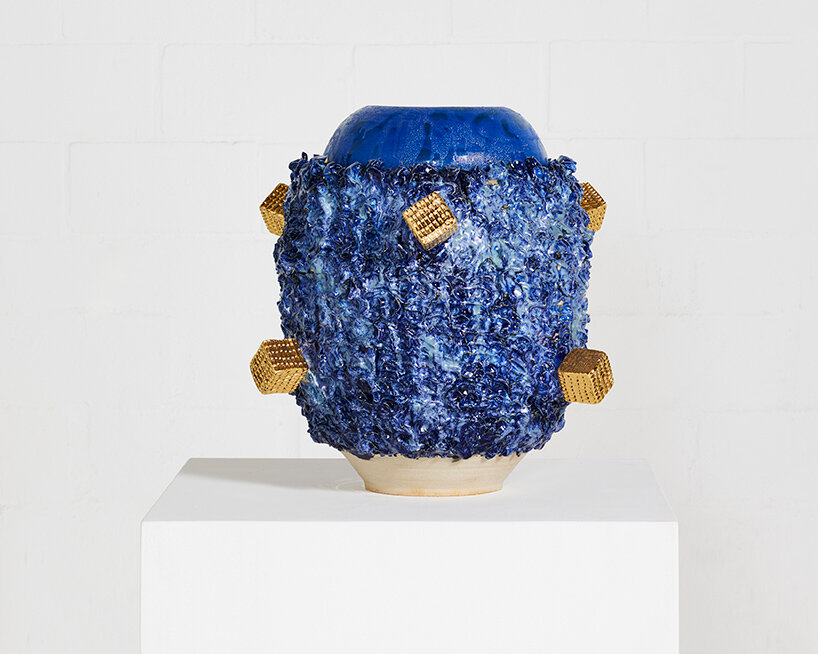
King Houndekpinkou, Blue Cavilux, Excavated From the Wonders of The Underworld, 2024 | image © Hayden Phipps, Southern Guild
DB: The textures and forms in your ceramic sculptures are both visually striking and symbolically rich. How do you approach the process of creating these intricate textures, and what do they represent in the context of your work?
KH: First, I form a vessel on the potter’s wheel. Then once it is leather hard, I add texture onto that clay body. The process of adding layers of clay is meditative and time seems suspended when I enter that zone. I can stay five to six hours in that state until the piece is fully covered.
Adding clay to a vessel structure feels like pulling out my inner matter (or flesh) to cleave it to the clay. It brings a visceral energy out of me. I symbolically empty myself, which then leads to a state of inner calmness and emptiness. Yet, it is a process that requires my attention as I need to be aware of the evolution of the form I’m building. Therefore, I navigate back and forth between the rational world and an unknown mental and spiritual space, like a trance.
When I started ceramics, my first desire was to understand how clay translated my inner world and who I am as a person. It was (and still is) deeply therapeutic. That is still one of the purposes that drives my creativity today.
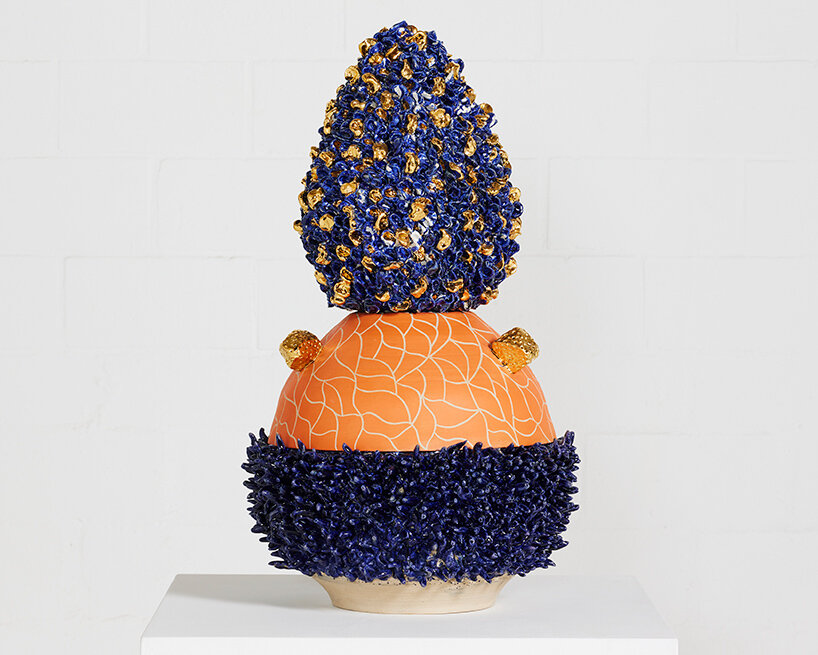
King Houndekpinkou, Outer Space Gold Ritual Vessel, I Refused to Let You Down, 2024 | image © Hayden Phipps, Southern Guild
DB: In Six Prayers you talk about creating new myths for new gods. Can you elaborate on the significance of this concept and how it is reflected in your sculptures?
KH: Myths are made of stories. Storytelling is what makes us human and at times it gives us the ability to make us seem ‘super-human.’ To me, the ceramics that I create can be considered as offerings to the ‘angels’ (gods may actually be too strong of a word) that have come my way and helped me grow and evolve as a person. I always say that the works I create are the materialization of life’s adventures I am fortunate to experience.
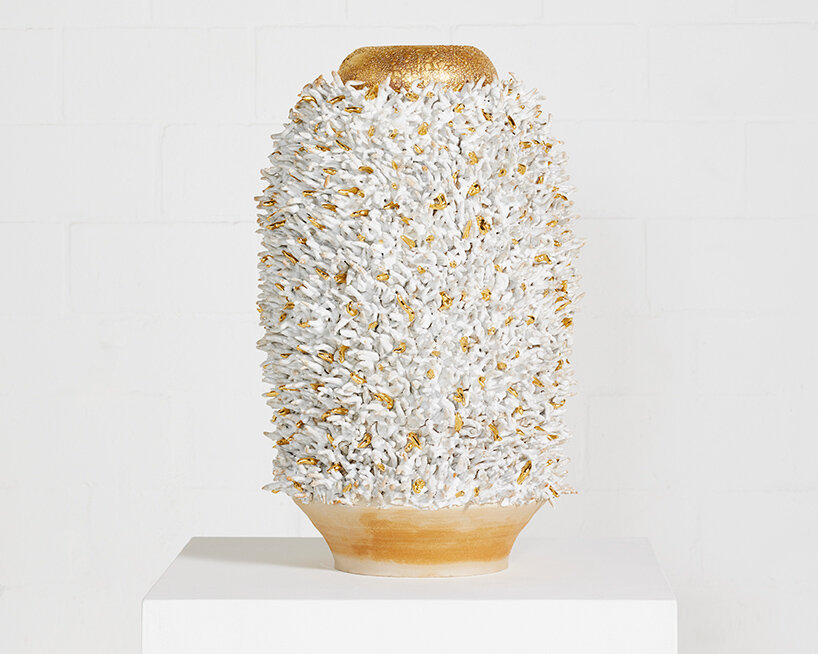
King Houndekpinkou, The Widow of Light, Bruised to The Bone, 2024 | image © Hayden Phipps, Southern Guild
(KH continued): You will notice that often my creations reference people or situations that have come my way during the creative process. For instance, one of the works in the show is called The Sea Widow: To All Those Brave Men Who Carried You Out of the Sea. It refers to the staff at Southern Guild that helped me with the logistics of the works – carrying them around from my studio to the kiln room and lastly to the exhibition space. This piece is partly an offering to them; a sign of gratitude. It also informs the viewer on the whole ecosystem that is often necessary in the making of single art piece. Never forget that human beings are central to all that we do.
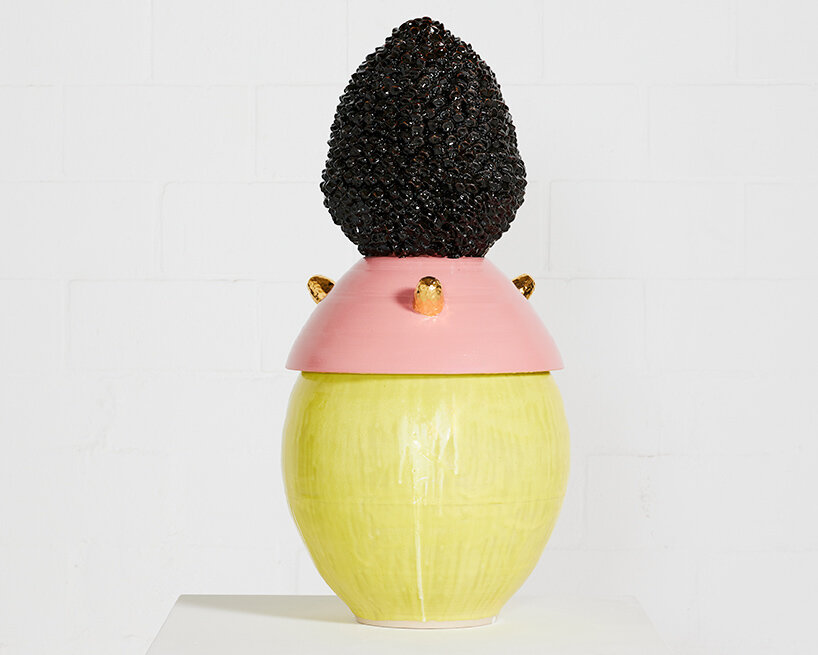
King Houndekpinkou, Jumbo Bubble Tea Doll, 2024 | image © Hayden Phipps, Southern Guild
DB: You mention that your work aims to make pieces look like they are ‘living, moving, and breathing.’ What techniques do you use to achieve and why is this quality important to you?
KH: It’s an intricate play between textures, colours, glazing techniques, spontaneity in execution, visceral tactile expression, and a meticulous attention to details without being too surgical about the work. It is my way to express that the objects of our daily lives carry some kind of soul and energy that have a repercussion on our lifestyle, good or bad — whether they are human-made, formed by nature, or manufactured by machines.
I like the notion of ‘charged’ objects and places. My works are based on the vessel shape, which is an object everyone knows and somehow takes for granted. It is so close to us that we don’t even ‘see’ it anymore. I use that shape and intentionally charge it using various textures, colour and matter so that it becomes full of life — to the point that you can’t deny that it carries substantial layers of stories.
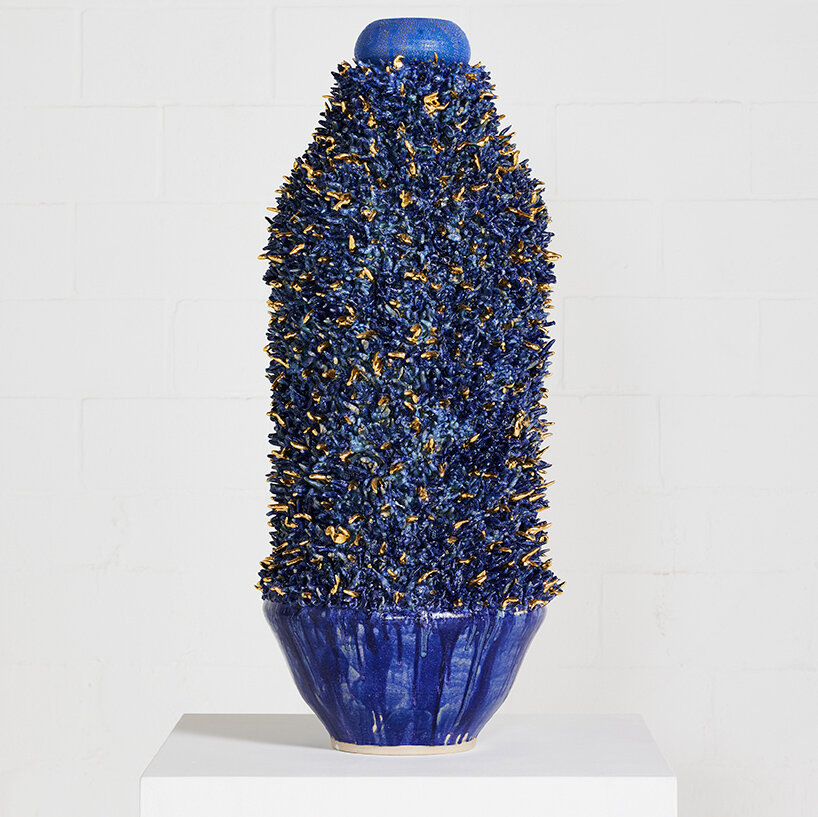
King Houndekpinkou, The Sea Widow, To All Those Brave Men Who Carried You Out of The Sea, 2024 | image © Hayden Phipps, Southern Guild
Madoda Fani
In Madoda: Let Us Now Praise Famous Men, artist Madoda Fani reimagines Black masculinity through the medium of clay. Taking inspiration from the title of James Agee and Walker Evans’ acclaimed work of non-fiction, Fani maps urban Black masculinities, challenging heteronormative narratives and stereotypes. His detailed ceramic works pay homage to the Black men who have influenced him, from his family members to ceramicist elders. Central to this body of work is the Primus stove, reconstituted in clay and adorned with spikes and scales, symbolizing both vulnerability and resilience. Fani’s pieces symbolize the tenderness and care inherent in the everyday lives of Black men, reshaping their representation with sensitivity and skill.
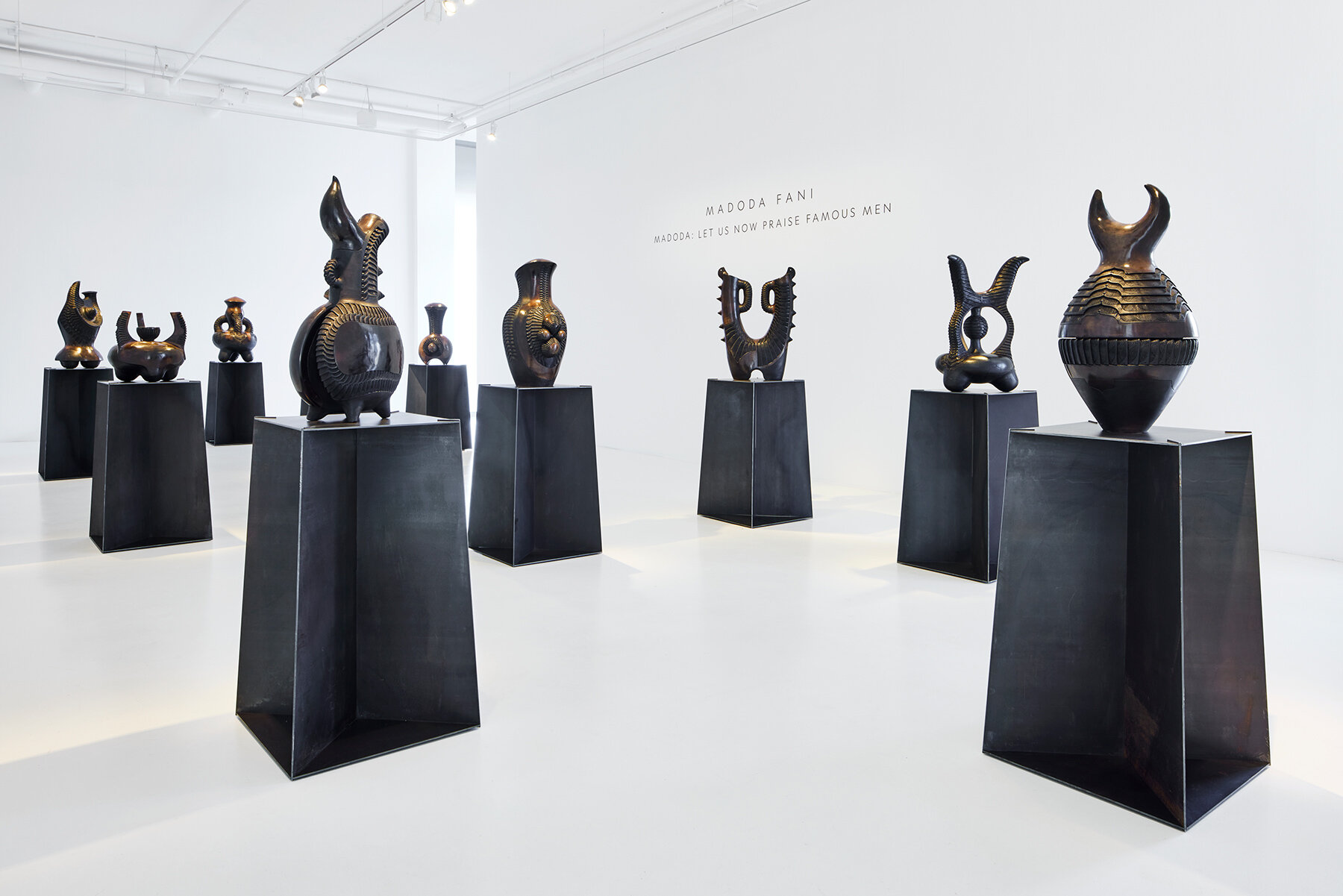
Madoda Fani, Madoda Let Us Now Praise Famous Men, 2024 | image © Hayden Phipps, Southern Guild
designboom (DB): As part of Madoda: Let Us Now Praise Famous Men, you intertwine your personal history with broader narratives of Black masculinities. Could you elaborate on how the figures in your life, such as your grandfather and father, influenced your artistic vision for this exhibition?
Madoda Fani (MF): Starting with my grandfather: he had a significant influence on me from a very young age. When I was around 10, I spent a lot of time with him, even more than with my father. My grandfather’s house was close to ours, and he was a man of many roles. He sold cool drinks, bread, and traditional beer (umqhombothi). He was a priest who also sold medicine around the township. He was always on the move, carrying a briefcase full of medicines to help people. Growing up around him, I saw the value of hard work and the importance of trying different things. He taught me the importance of community and versatility.
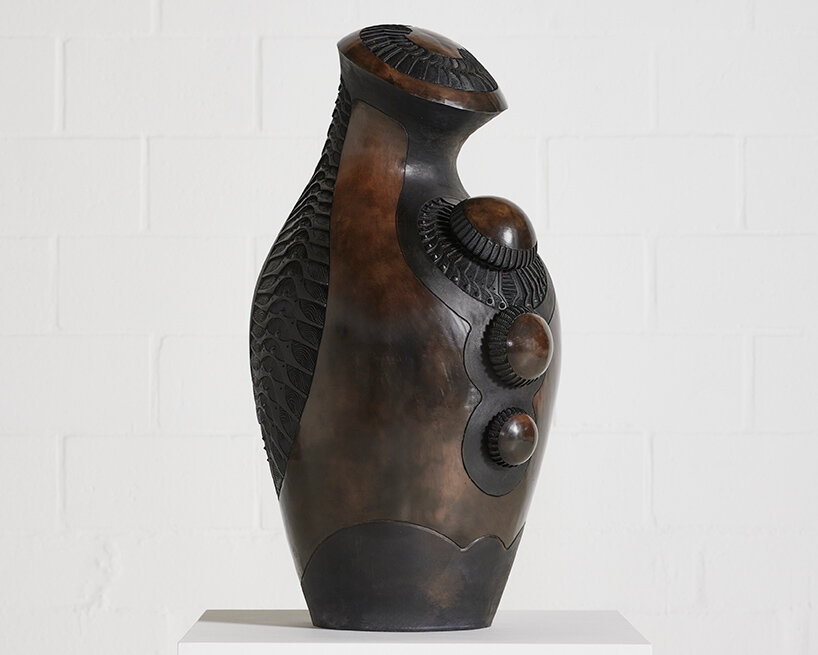
Madoda Fani, Gugulethu, 2024 | image © Hayden Phipps, Southern Guild
(MF continued): My father, on the other hand, worked as a construction worker specialising in roofs. He would bring home scrap metal pieces from his job and weld them into various objects. Although he never formally studied art, he was very creative, often making sculptures at home. We didn’t have many conversations, but he would communicate through art. He would give me a book to sketch in, and that was our way of bonding. Watching him turn discarded materials into something new inspired me deeply.
Even though my father didn’t see himself as an artist, his creativity left a lasting impression on me. I still have one of his creations, an axe, which I treasure. He was also quite bold in his approach to life, like when he painted our house pink in the 80s, setting trends without even realising it. His influence on me was profound, as was the influence of all the men I grew up around.
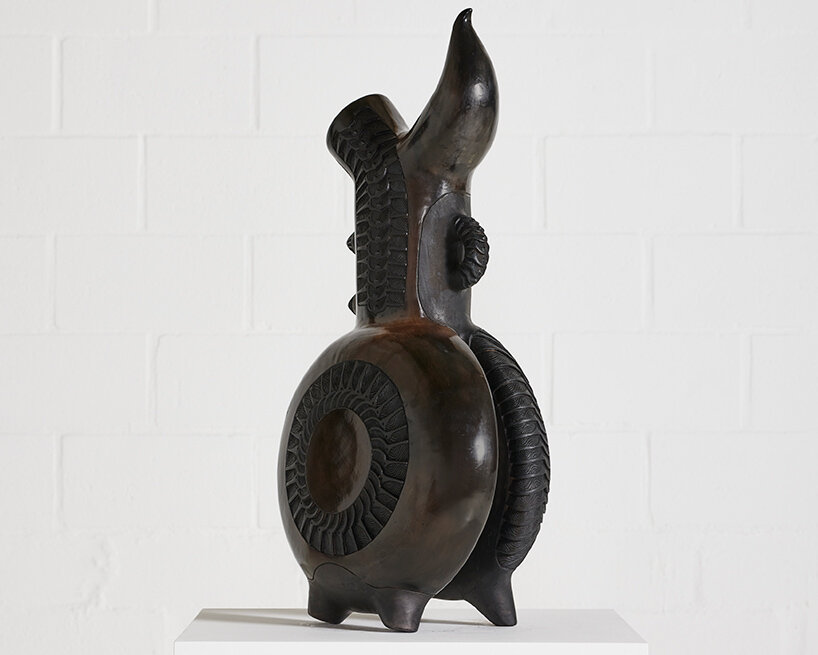
Madoda Fani, Masoka, 2024 | image © Hayden Phipps, Southern Guild
DB: The Primus stove is a central allegorical object in your work, symbolizing Black manhood and vulnerability. What drew you to this specific object, and how do you see it encapsulating the themes of your exhibition?
MF: Growing up, we didn’t have an electric stove at home, so we used a Primus stove for cooking. Like many other homes, this stove was a central part of our daily life and gatherings. I remember us all sitting around it as my mother cooked.
This stove also reminds me of our black-and-white TV, a gift to my mother from her employers when they upgraded to a colour TV. Our house became a gathering spot for the neighbourhood, with children and adults alike coming over to watch TV together.
The Primus stove symbolises more than just cooking; it was a place where stories were shared, creativity flourished, and connections were forged. Even though some families with TVs and food would close their doors to keep others out, our home remained open and inviting. For me, this stove holds all these themes of community, protection, and the everyday struggles and joys of life.
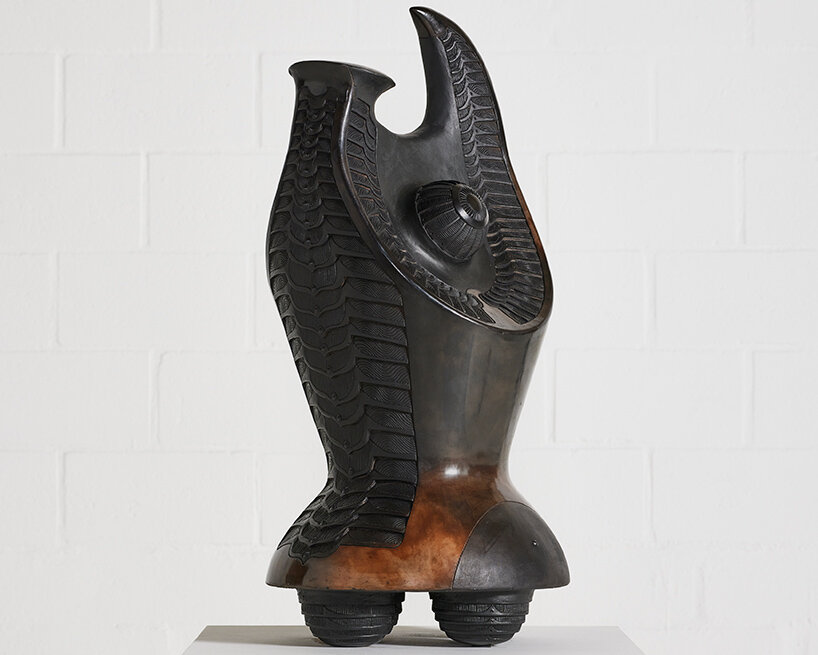
Madoda Fani, Mzwenkosi, 2024 | image © Hayden Phipps, Southern Guild
DB: Your process involves hand-coiling, smoke-firing and detailing each piece to create a rhythmic and meditative practice. How does this process reflect the themes of tenderness and resilience that you explore in your work?
MF: When I coil the pieces, it requires a great deal of patience. I don’t complete a piece in one go. Instead, I create a coil, let it dry just enough to handle some weight, and then continue with the next part. This element of patience is fundamental to my process and mirrors the tenderness and rigour needed to nurture and develop something over time.
Carving is another aspect that involves meditation. When I’m in this phase, I enter a zone where I’m intensely focused and connected with the clay. I prefer to be alone and totally immersed in this part of the process. The most powerful part of the entire creative journey is the patience it demands. Creating these pieces can take a significant amount of time, often weeks and even months on end, but my focus is always on the finished product. I visualise how it will look when it’s done, and this vision guides me through the process, regardless of how long it takes. This intense focus on the end product, rather than the time it takes to achieve it, pulls me through.
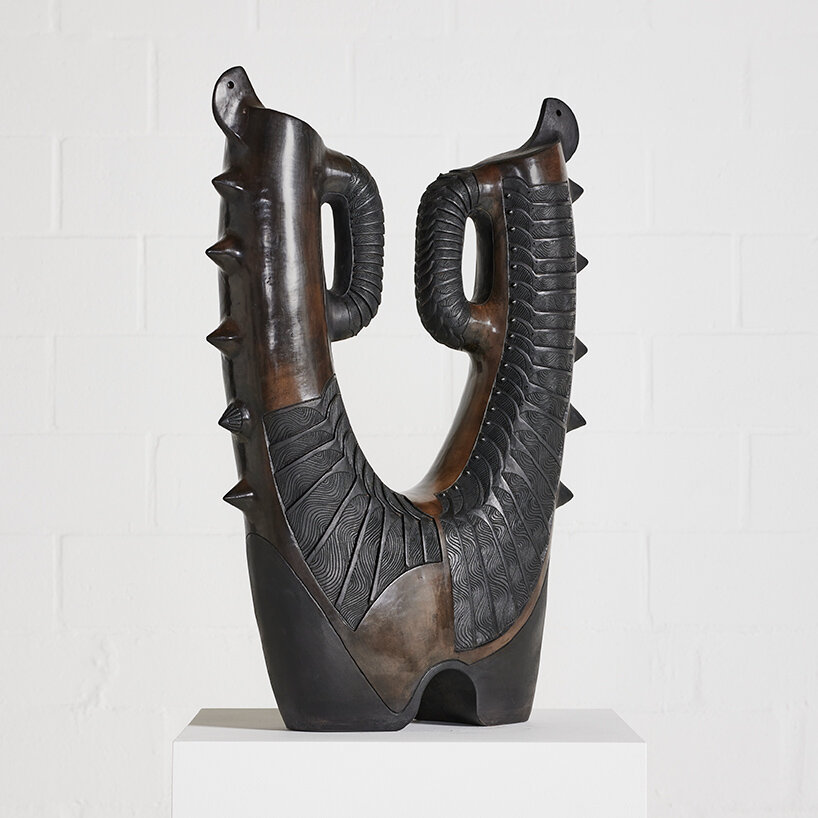
Madoda Fani, Imbewu, 2024 | image © Hayden Phipps, Southern Guild
DB: In your work, you deconstruct and reconstitute everyday objects, challenging reductive and harmful clichés about Black masculinities. Can you discuss how this approach allows you to create new narratives and what you hope viewers take away from this re-imagining?
MF: The Primus stove here is hearth around people, men to gather. As I played with its shape, elongating is rivets and structures, playing around with making them softer or harder, I also stretched out these narratives of Black men in the township. I want to give these stories about men more room to be contemplated and experiment with meaning: what does it mean to be a man and how is a man constructed? What do we see when we look at a Black man?
project info:
exhibitions: Like Something Almost Being Said (Adam Birch), Six Prayers (King Houndekpinkou), Madoda: Let Us Now Praise Famous Men (Madoda Fani)
gallery: Southern Guild Cape Town
location: Silo 5, V&A Waterfront, Cape Town, South Africa
on view: June 6th — August 22nd, 2024
photography: © Hayden Phipps (unless otherwise stated)
